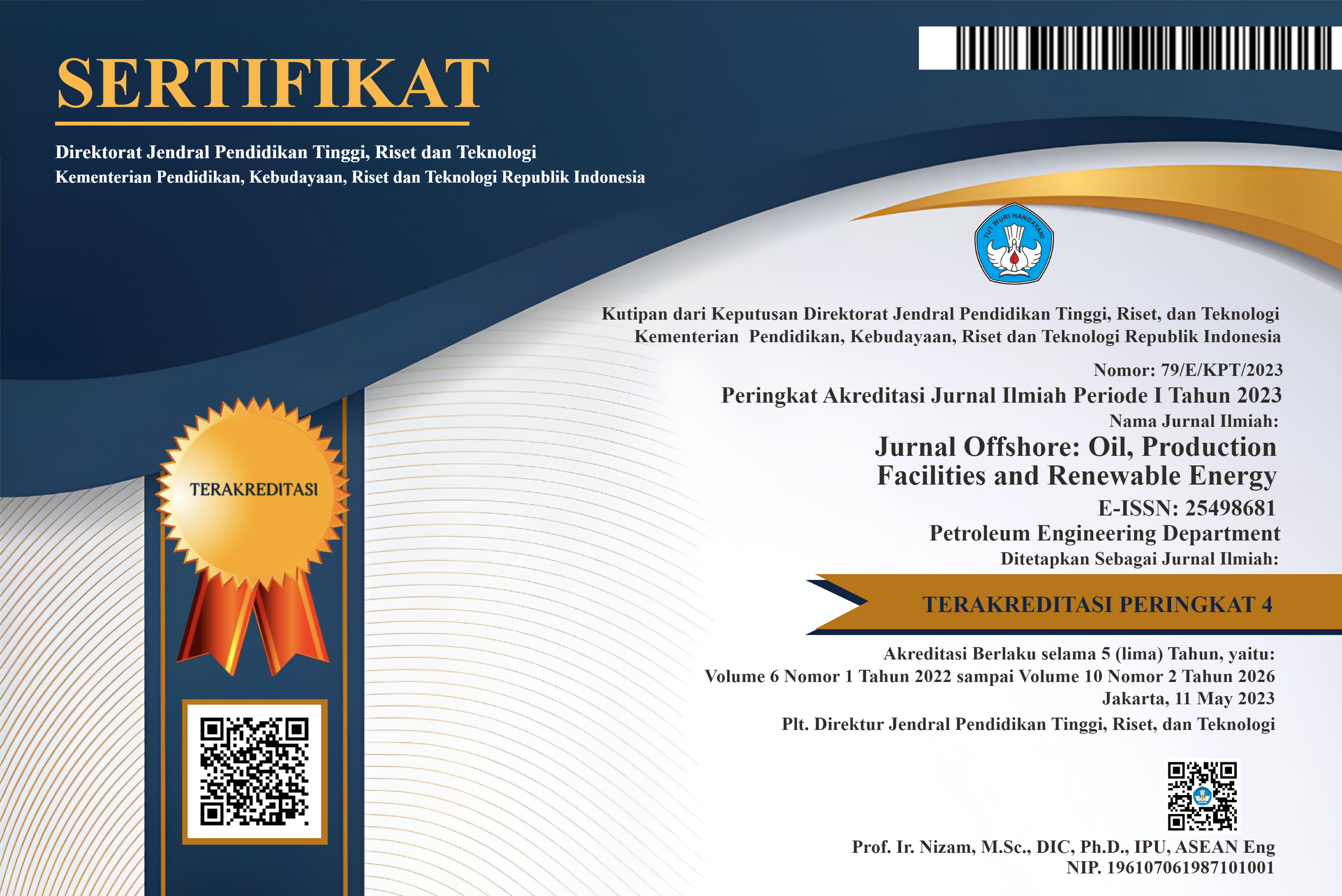Pengolahan Air Terproduksi Pada Lapangan "FD"
DOI:
https://doi.org/10.30588/jo.v4i1.760Abstract
Proses pemisahan minyak, gas terlarut dan air produksi bersama akan diproses melalui Gas Boot - Wash Tank (Gun Barrel) - Shipping Tank - Clarifeier Tank - WTP Unit - peralatan Balance Tank. Minyak yang telah dipisahkan dari gas terlarut dan air terproduksi akan dialirkan ke tangki pengiriman. Sedangkan air terproduksi yang telah dipisahkan dari minyak dan gas terlarut di Wash Tank dan Gas boot akan dialirkan ke tangki clarifier dan selanjutnya diproses di unit WTP. Peralatan pendukung yang akan digunakan pada WTP Unit adalah Buffer Tank - Electro Coagulant (EC) - DAF Unit (solved air flotation) - Sludge Dewatering Unit - Filter Media - Balance Tank
Pada WTP (Water Treating Plant) ini air akan diolah untuk menghasilkan air yang sesuai dengan baku mutu yang telah ditetapkan berdasarkan Peraturan Menteri Lingkungan Hidup No. 19/2010. Parameter yang harus dipenuhi dalam proses pemisahan ini adalah kandungan oli harus 25 mg /l, kekeruhan yang dihasilkan harus memenuhi kriteria 149 NTU dan tingkat kekerasan di bawah 1 ppm karena jika lebih dari 1 ppm maka air ini akan cenderung membentuk sangat kerak dan korosi. mengganggu di industri perminyakan, TSS yang dihasilkan (Total Suspended Solid) harus memenuhi kriteria 3 mg / l, TDS yang dihasilkan (Total Dissolved Solid) juga harus memenuhi kriteria 5000 mg / dan RPI yang dihasilkan (relative plugging Index) juga harus memenuhi kriteria 10.
Parameter air terproduksi yang diolah di unit WTP sudah memenuhi baku mutu, RPI (Relative Plugging Index) yang dihasilkan adalah 2.96 - 6.47. Kekeruhan yang dihasilkan (tingkat kekeruhan air) 1.64 - 6.72 NTU, TSS (Total Suspended Solid) yang dihasilkan 1.3 - 2,66 mg/l, TDS (total padatan terlarut) dihasilkan 4530 - 4910 mg/l, Kandungan minyak (kandungan minyak dalam air) 16,66 - 23,66 mg/l, dan PH 8,39 - 8,83.
Kata Kunci : Sistem Gathering, Pengolahan, Air Terproduksi.
Abstract
The process of separating oil, dissolved gas and co-produced water will be processed through the Gas Boot - Wash Tank (Gun Barrel) - shipping Tank - Clarifeier Tank - WTP Unit - Balance Tank equipment. Oil that has been separated from dissolved gas and produced water will be flowed to the shipping tank. Meanwhile, the produced water that has been separated from the oil and dissolved gas in the Wash Tank and Gas boot will be flowed to the clarifier tank and will be further processed in the WTP unit. The supporting equipment that will be used in the WTP Unit is a Buffer Tank - Electro Coagulant (EC) - DAF Unit (dissolved air flotation) - Sludge Dewatering Unit - Filter Media - Balance Tank
In this WTP (water Treating plant) the water will be processed to produce water that is in accordance with the quality standards that have been determined based on the Minister of Environment Regulation No. 19/2010. The parameters that must be met in this separation process are that the oil content must be 25 mg / l , the resulting turbidity must meet the 149 NTU criteria and the hardness level is below 1 ppm because if it is more than 1 ppm then this water will tend to form very scale and corrosion. disturbing in the petroleum industry, the resulting TSS (Total Suspended Solid) must meet the criteria of 3 mg / l, the resulting TDS (Total Dissolved Solid) must also meet the criteria of 5000 mg / and the resulting RPI (relative plugging Index) must also meet the criteria 10.
The produced water parameters processed in the WTP unit have met the quality standard, the RPI (Relative Plugging Index) produced is 2.96 - 6.47, the resulting Turbidity (water turbidity level) is 1.64 - 6.72 NTU, TSS (Total Suspended Solid) produced 1.3 - 2.66 mg / l, TDS (total dissolved solid) produced 4530 - 4910 mg / l, Oil content (oil content in water) 16.66 - 23.66 mg / l, and PH 8.39 - 8.83.
Keyword : Gathering System, Processing, Produced Water.References
Desalination Of Produced Water From Oil Production Fields By Membrane Processes. Desalination, Vol. 222, Hlm. 176-186.
Cahyono, Eko. 1991. Proses Pemisahan Minyak Mentah,Gas Dan Air Serta Pemakaian Bahan-Bahan Kimia di lapangan Minas Tugas Akhir Universitas Islam Riau.
Fakhru’l-Razi., Pendashteh, A., Abdullah, L.C., Biak, D.R.A., Madaeni, S.S., Abidin, Z.Z. 2009. Review Of Technologies For Oil And Gas Produced Water Treatment. Journal of Hazardous Materials, Vl. 170, Hlm. 530-
Judd, S., Qiblawey, H., Al-Marri, M., Clarkin, C., Watson, S., Ahmed, A., Bach, S. 2014. The Size And Performance Of Offshore Produced Water Oil-Removal Technologies For Injection. Separation and Purification Technology, Vol. 134, Hlm. 241-246.
Robinson, David. 2013. Oil And Gas: Treatment And Discharge Of Produced Waters Onshore. Filtration + Separation, Volume50, Issue 3, May–June 2013, Hlm. 40– 46
Production Training. 2007. Gathering Station. Human resource training&education North Operation Duri.
Downloads
Published
How to Cite
Issue
Section
License
Authors retain copyright and grant the Jurnal Offshore right of first publication with the work simultaneously licensed under a Creative Commons Attribution 4.0 International License that allows others to share (copy and redistribute the material in any medium or format) and adapt (remix, transform, and build upon the material) the work for any purpose, even commercially with an acknowledgement of the work's authorship and initial publication in Jurnal Offshore. Authors are able to enter into separate, additional contractual arrangements for the non-exclusive distribution of the journal's published version of the work (e.g., post it to an institutional repository or publish it in a book), with an acknowledgement of its initial publication in Jurnal Offshore. Authors are permitted and encouraged to post their work online (e.g., in institutional repositories or on their website) prior to and during the submission process, as it can lead to productive exchanges, as well as earlier and greater citation of published work (See The Effect of Open Access).















